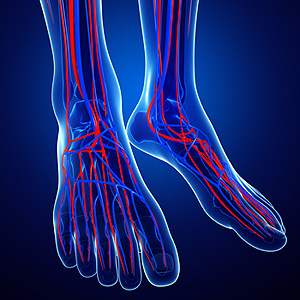Items filtered by date: July 2023
Heel Spurs Can Be Painful

A calcium build-up on the underside of the heel may indicate a heel spur has developed. It can happen by increasing speed and distance too quickly while running or by wearing shoes with inadequate support. Additionally, medical conditions such as rheumatoid arthritis may cause a heel spur to develop. Regardless of the cause, a heel spur can be painful, and walking can become difficult. A diagnosis is often performed, which consists of having an X-ray taken. This is successful in ruling out a fractured heel bone. The symptoms associated with a heel spur can include sharp pain under the foot, which may become worse after a prolonged time of rest, and the affected foot may feel warm when touched. Treatment can begin with elevating the foot and temporarily stopping the activity that may have caused the heel spur. Performing specific stretches may help to alleviate some of the discomfort, as well as to maintain a healthy weight. If you have heel pain, it is strongly suggested that you speak to a podiatrist as soon as possible who can effectively diagnose and treat heel spurs.
Heel spurs can be incredibly painful and sometimes may make you unable to participate in physical activities. To get medical care for your heel spurs, contact Gary J. Kaiserman, DPM from Achilles Footcare Center. Our doctor will do everything possible to treat your condition.
Heels Spurs
Heel spurs are formed by calcium deposits on the back of the foot where the heel is. This can also be caused by small fragments of bone breaking off one section of the foot, attaching onto the back of the foot. Heel spurs can also be bone growth on the back of the foot and may grow in the direction of the arch of the foot.
Older individuals usually suffer from heel spurs and pain sometimes intensifies with age. One of the main condition's spurs are related to is plantar fasciitis.
Pain
The pain associated with spurs is often because of weight placed on the feet. When someone is walking, their entire weight is concentrated on the feet. Bone spurs then have the tendency to affect other bones and tissues around the foot. As the pain continues, the feet will become tender and sensitive over time.
Treatments
There are many ways to treat heel spurs. If one is suffering from heel spurs in conjunction with pain, there are several methods for healing. Medication, surgery, and herbal care are some options.
If you have any questions feel free to contact our offices located in Forest Lane and West Kiest Boulevard Dallas, TX . We offer the latest in diagnostic and treatment technology to meet your needs.
Treat Your Feet to Diabetic Shoes
Morton’s Neuroma and High Heels

Some people feel the sensation of having a small pebble in their sock or shoe, and this can be a symptom of the foot condition known as Morton’s neuroma. It can develop as a result of wearing shoes that do have enough room in the toe area to move freely in. High heels can fall into this category and can affect women who frequently wear this type of shoe. This ailment affects the nerve between the third and fourth toes and can cause severe pain and discomfort. The nerve can become compressed and irritated, and mild relief may be felt when the shoes that are worn have a wider toe box. This condition will not improve when high heels are consistently worn, and surgery may be necessary to remove or repair the nerve. Patients may find some relief when anti-inflammatory medications are taken and the affected foot is massaged. If you have pain in this part of your foot, it is suggested that you visit a podiatrist who can diagnose and treat Moton’s neuroma.
Morton’s neuroma is a very uncomfortable condition to live with. If you think you have Morton’s neuroma, contact Gary J. Kaiserman, DPM of Achilles Footcare Center. Our doctor will attend to all of your foot care needs and answer any of your related questions.
Morton’s Neuroma
Morton's neuroma is a painful foot condition that commonly affects the areas between the second and third or third and fourth toe, although other areas of the foot are also susceptible. Morton’s neuroma is caused by an inflamed nerve in the foot that is being squeezed and aggravated by surrounding bones.
What Increases the Chances of Having Morton’s Neuroma?
- Ill-fitting high heels or shoes that add pressure to the toe or foot
- Jogging, running or any sport that involves constant impact to the foot
- Flat feet, bunions, and any other foot deformities
Morton’s neuroma is a very treatable condition. Orthotics and shoe inserts can often be used to alleviate the pain on the forefront of the feet. In more severe cases, corticosteroids can also be prescribed. In order to figure out the best treatment for your neuroma, it’s recommended to seek the care of a podiatrist who can diagnose your condition and provide different treatment options.
If you have any questions, please feel free to contact our offices located in Forest Lane and West Kiest Boulevard Dallas, TX . We offer the newest diagnostic and treatment technologies for all your foot care needs.
How Can I Relieve Symptoms From Poor Circulation?

Common symptoms of poor circulation are tingling sensations in the feet after sitting for long periods or if exposed to cold elements. There may be existing medical conditions that can cause poor circulation. High blood pressure can be a common reason, as it could represent limited blood flow to the organs. People who smoke may be prone to developing poor circulation, and the effects are often felt in the lower legs and feet. Poor circulation may also happen from having endured a foot injury, which may constrict blood flow. It is important for patients who lead a sedentary lifestyle to move around as much as possible. Engaging in a gentle exercise program is an effective way to accomplish this, and can provide adequate circulation to the body. If you would like additional knowledge about how poor circulation can affect the feet, it is suggested that you confer with a podiatrist.
Poor circulation is a serious condition and needs immediate medical attention. If you have any concerns with poor circulation in your feet contact Gary J. Kaiserman, DPM of Achilles Footcare Center. Our doctor will treat your foot and ankle needs.
Poor Circulation in the Feet
Poor blood circulation in the feet and legs is can be caused by peripheral artery disease (PAD), which is the result of a buildup of plaque in the arteries.
Plaque buildup or atherosclerosis results from excess calcium and cholesterol in the bloodstream. This can restrict the amount of blood which can flow through the arteries. Poor blood circulation in the feet and legs are sometimes caused by inflammation in the blood vessels, known as vasculitis.
Causes
Lack of oxygen and oxygen from poor blood circulation restricts muscle growth and development. It can also cause:
- Muscle pain, stiffness, or weakness
- Numbness or cramping in the legs
- Skin discoloration
- Slower nail & hair growth
- Erectile dysfunction
Those who have diabetes or smoke are at greatest risk for poor circulation, as are those who are over 50. If you have poor circulation in the feet and legs it may be caused by PAD and is important to make changes to your lifestyle in order to reduce risk of getting a heart attack or stroke. Exercise and maintaining a healthy lifestyle will dramatically improve conditions.
As always, see a podiatrist as he or she will assist in finding a regimen that suits you. A podiatrist can also prescribe you any needed medication.
If you have any questions please feel free to contact our offices located in Forest Lane and West Kiest Boulevard Dallas, TX . We offer the newest diagnostic and treatment technologies for all your foot and ankle needs.
Foot Pain Facts

The feet are complex structures that are the foundation of our movement. Foot pain can be caused by something within or related to the feet or a medical condition elsewhere in the body. Feet are made up of bone, joints, ligaments, muscles and tendons, nerves, blood vessels, skin, and soft tissue. Anything affecting any of these things can cause foot pain. A virus, diabetes, or arthritis can also cause foot pain. Treatment depends on the cause of the pain and can involve anything from taking medication, exercising the feet, or, if severe, undergoing surgery. The location of the pain and how and when it occurs are used in diagnosing the cause of the problem. If you have foot pain, it is suggested that you see a podiatrist who can evaluate your feet and help you return to a comfortable state.
Foot Pain
Foot pain can be extremely painful and debilitating. If you have a foot pain, consult with Gary J. Kaiserman, DPM from Achilles Footcare Center. Our doctor will assess your condition and provide you with quality foot and ankle treatment.
Causes
Foot pain is a very broad condition that could be caused by one or more ailments. The most common include:
- Bunions
- Hammertoes
- Plantar Fasciitis
- Bone Spurs
- Corns
- Tarsal Tunnel Syndrome
- Ingrown Toenails
- Arthritis (such as Gout, Rheumatoid, and Osteoarthritis)
- Flat Feet
- Injury (from stress fractures, broken toe, foot, ankle, Achilles tendon ruptures, and sprains)
- And more
Diagnosis
To figure out the cause of foot pain, podiatrists utilize several different methods. This can range from simple visual inspections and sensation tests to X-rays and MRI scans. Prior medical history, family medical history, and any recent physical traumatic events will all be taken into consideration for a proper diagnosis.
Treatment
Treatment depends upon the cause of the foot pain. Whether it is resting, staying off the foot, or having surgery; podiatrists have a number of treatment options available for foot pain.
If you have any questions, please feel free to contact our offices located in Forest Lane and West Kiest Boulevard Dallas, TX . We offer the newest diagnostic and treatment technologies for all your foot care needs.

